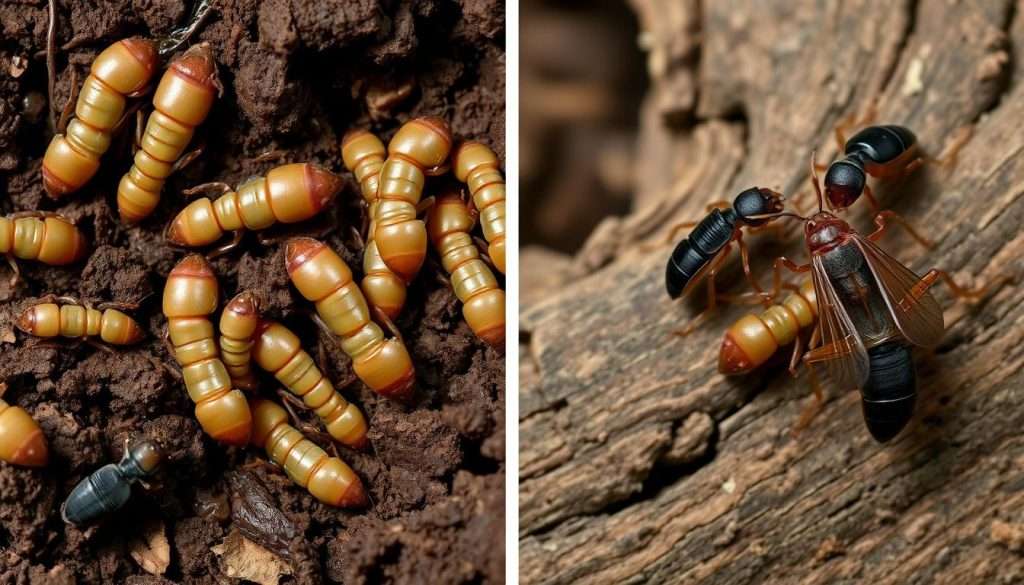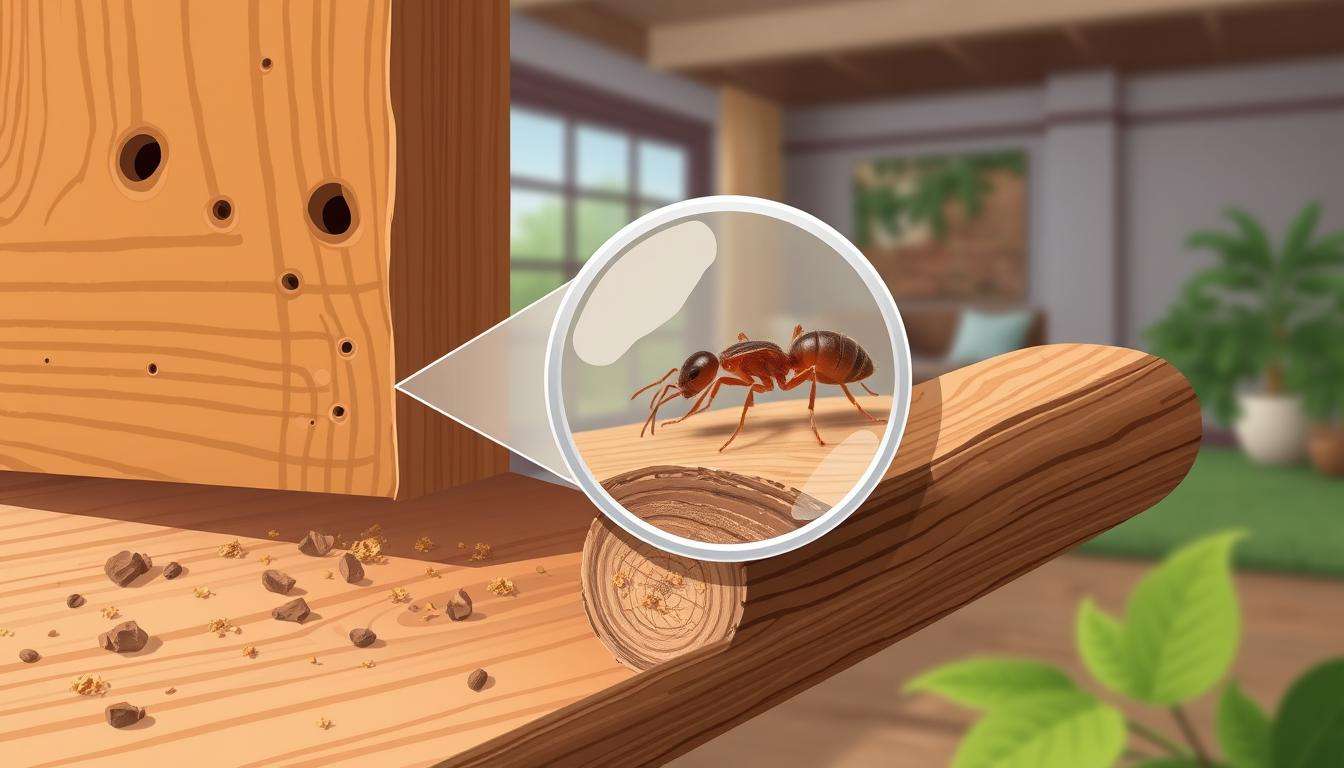Termites can damage homes a lot, often without being noticed. Knowing how to spot them is key to protecting your home. Learning the signs can help you catch termites early.
Termites cause over $5 billion in damage each year in the U.S. It’s important to know the signs of an infestation. This guide will teach you about termite signs and how to control them. This way, you can keep your home safe.
Termites usually swarm at least once a year. They leave signs like droppings and mud tubes. Knowing these signs can help protect your property.
By learning these signs, you’re taking a big step to protect your home. Let’s explore more about termites to help you fight them.
Key Takeaways
- Termites cause over $5 billion in property damage annually in the U.S.
- Mature termites swarm at least once a year, signaling potential infestations.
- Subterranean termites use mud tubes as bridges to wood sources.
- Drywood termites leave behind frass, their droppings, as evidence of activity.
- Visual signs like small wing piles can indicate recent swarming.
- Most properties in the U.S. face the risk of termite infestations.
- Timely detection is crucial; regular inspections can help mitigate damage.
Understanding Termites and Their Behavior
To manage termites well, knowing their types and behavior is key. Termites are small, but they can harm our homes. They play a big role in nature but can be a problem near buildings. The main types of termites are:
Types of Termites
- Subterranean termites: These termites live in damp soil and make tunnels to get to food above. They eat wood and can damage buildings a lot. They also send out many swarmers, making them hard to control.
- Drywood termites: These termites live in the wood they eat, like furniture and wall beams. They don’t send out as many swarmers. You might see frass, or pellets, where they are.
- Dampwood termites: These termites like moist, rotting wood. They can damage wood a lot, especially in wet places.
Subterranean and drywood termites eat cellulose, found in plants, trees, and building materials. They can cause a lot of damage. In the U.S., termite damage costs over $5 billion each year.
What Makes Termites Dangerous
Termites can damage buildings without being seen for a long time. Subterranean termites make mud tubes to get into buildings. Drywood termites tunnel through wood. Finding them early is hard.
Termites can also be expensive to deal with. Insurance usually doesn’t cover termite damage. Knowing what termites you have helps find the best way to fix the problem.

Learning about termites helps protect your home. Regular checks and knowing about termites can lower the chance of an infestation.
How To Tell If You Have Termites
Spotting termite signs early can save your home from big damage. Look for swarmers and their wings, and mud tubes. Knowing these signs helps you act fast against termites.
Identifying Swarmers and Their Wings
Termite swarms happen in spring, showing they’re around. Winged termites come out to mate and start new homes. You might see discarded wings near windows, doors, or your foundation. This means a colony is close and needs quick action.
Recognizing Mud Tubes
Mud tubes are another sign of termites. These tubes, made of soil and saliva, help termites get to wood. They’re about a pencil’s width and look wet. Seeing them on walls or near your foundation means termites are there. It’s time for a pro to check.

Common Signs of Termite Infestation
Spotting termite infestation early can save you a lot of money. It also stops more damage. Knowing the signs can help you act fast to protect your home.
Visible Damage to Wood Structures
Look out for sagging wood or hollow sounds when tapping on beams or floors. This could mean termites are at work. They make wood soft and weak.
Check for:
- Blistered wood surfaces
- Damaged roof tiles, walls, or ceilings
- Disintegration of skirting boards
Signs of Termite Droppings
Termite droppings are another clear sign. Drywood termites leave wood powder pellets. Find these in windowsills, under furniture, or near wood.
Other signs include:
- Dark patches or stains on internal walls
- Presence of discarded wings near window tracks or doors
Indicators of Structural Issues
Termite infestations can cause big structural problems. Watch for:
- Unusual clicking sounds from walls at night, indicating active termite behavior
- Soft spots in wood that should feel solid
- Visual evidence of mud tubes that lead to nests, typically built in basements or along the exterior
| Signs | What to Look For |
|---|---|
| Visible Damage | Sagging wood, hollow sounds, blistered surfaces |
| Termite Droppings | Pellets in corners, wings near entry points |
| Structural Issues | Soft wood, clicking noises, mud tubes |
Spotting these signs early lets homeowners act fast. Knowing about termite droppings and structural issues can save you time, effort, and money.
Reasons for Regular Termite Inspection
Regular termite inspections are key to keeping your home safe. Termites can sneak in without you noticing, causing big damage. Catching them early means you can stop the damage and save money.
The Importance of Early Detection
Finding termites early can save your home. In Gainesville and nearby, homes often go years without being checked. Experts say the best way to find termites is through professional inspections.
Look out for these signs:
- Mud tunnels near the foundation
- Sawdust-like droppings from termites
- Hollow sounds when knocking on walls
- Increased vulnerability caused by water damage
About 600,000 homes in the U.S. face termite damage each year. Experts say it’s smart to act fast based on what an inspection finds.
Annual Inspection Recommendations
Annual checks are a must in Gainesville. Doing this every year or every two years helps keep termites away. Here’s why:
- Check before listing your home to fix any problems
- Get a Wood Destroying Insect Report when buying a home
- Use experts who can find up to 80% of hidden damage
Many termite control services use new tech for early detection. Working with pros like MightyMite Termite Services or ExtermPRO can really help.
Conclusion
Knowing how to spot termites is very important for homeowners, especially in places like Brookline, Massachusetts. This area is at high risk for termite infestations. By watching for signs like mud tubes and wood damage, you can act fast to stop termites before they harm your home.
Termites can damage your home quickly, sometimes in just a few months. Spotting signs like discarded wings or termite sounds is key to quick action. Getting help from experts like F&W Pest Control can save you from expensive repairs later.
Preventing termites means staying alert and checking your home often. Knowing how to fight these pests is crucial for protecting your home. For more tips on finding termites, check out this guide on identifying termite infestations. Don’t forget to book your yearly termite check-up today.
